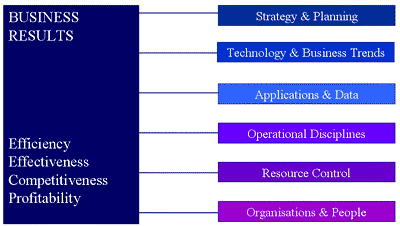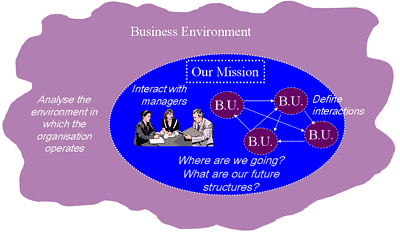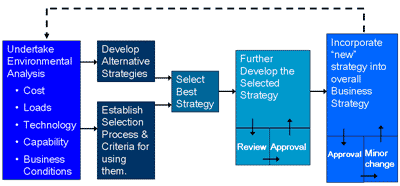Developing an I.T. Strategy
![]()
![]()
![]()
Introduction - The Importance of Strategy
Managers in an organisation who wish to take advantage of IT and other strategic opportunities must apply a systematic, strategic vision to define the organisational direction.

A Model of I.T. Management
A strategy is defined as a collection of statements that express or propose a means through which an organisation can fulfil its primary purpose or mission.
A strategy must focus and coordinate an organisation’s activity from the top down to achieve its mission. Such a well-developed strategy ensures consistent direction within the company’s business units, and reduces uncertainty in decision making.
A business unit is the lowest level of the company which contains the set of functions that carry a product through its life span from concept through manufacture, distribution, sales and service.
To align IT objectives with corporate objectives, managers must believe that the IT strategy is a strategy for the whole organisation. Intellectual alignment is achieved when written IT and business objectives are internally and externally consistent and cross-referenced. IT and business executives who clearly understand each other’s objectives achieve social alignment.
The development of a sound strategy requires…
- Thoughtful understanding of the organisation’s mission.
- Analysis of the operating environment.
- Extensive interaction with senior executives and other managers.
- Detailed definition of how the company’s business units interact.
In addition, strategists must be able to predict possible changes in the organisational structure.

The Strategic Challenge
Elements of a Strategy
A strategy can be described as having six components:
- Environmental assessment – also called environmental scanning – identifies the important trends that may impact the organization and its functional units. These trends can be political, economic, legal, technological and organisational.
- Mission statement – defines the purpose of the organisation, in terms of what it seeks to accomplish.
- Statement of objectives – what is intended to be achieved in terms of desirable states towards which action is directed.
- Expression of strategy – the course of action that will lead to the achievement of objectives.
- Maintenance of processes –review of the environment and identifying change leads to assessment of the course of actions.
- Performance assessment – evaluation of how well the organisation has achieved its goals and objectives.
Relationship Between Strategies and Plans

The Relationship Between Strategies and Plans
Strategies and plans seem to run together, but they are clearly different.
A strategy is a collection of statements that expresses or proposes a means through which an organisation can fulfil its primary purpose or mission.
On the other hand, a plan is a detailed description of how an organisation can accomplish its primary purpose or mission.
Strategy is not about plans – it is about insights!
The strategic plan describes detailed actions for the next year or two, and less detailed actions beyond two years (often for 3 to 5 years in total). Also called the long-term plan.
The detailed actions for the next year (or two) are usually called the tactical or near-term plan.
Strategic Management
The processes of strategy development and strategic planning are the essential elements of strategic planning. This reflects a changing attitude to business strategy – businesses now try to create the future (rather than predict it) via the following:

Strategic management reorganises and deploys resources to attain competitive advantage. It also implements creative, flexible long- and short-range planning systems supporting resource deployment actions.
Because IT has considerable potential for initiating, shaping and supporting future change, IT managers play a vital role in strategy development for organisations.
In most businesses functional units – e.g. manufacturing, marketing or IT – have two types of strategies, functional strategies and stand-alone strategies.
- Functional strategies describe the unit’s broad goals and objectives, whereas
- Stand-alone strategies describe an individual, one-time goal or opportunity.
For example, an IT organisation’s functional strategy describes the actions IT must take to support the entire business in the long term. It also has a stand-alone strategy to upgrade the corporate telecommunication network.
The IT strategy combines these two. The complete strategy for any function within the organisation aggregates its stand-alone strategies with its functional strategy.
The IT Functional Strategy must contain the following basic elements:
- Support of business objectives
- Technical support
- Organisational support
- Budget and financial matters
- Personal considerations
Business strategies – those that support core business activity – are developed by the product managers who are responsible for producing revenue and profit.
The aggregation of all functional and and business strategies comprises the organisation’s complete business strategy.

The organisation’s business strategy is the detailed document that outlines the business’s strategic goals and objectives, and shows how all the business units within the organisation will contribute to achieving the objectives and mission.
For an organisation to succeed, its overall business strategy must be based upon internal goal congruence – that all the goals are similar.
In special circumstances a functional unit will want (or need to) develop a specific “stand-alone strategy” to deal with a unique opportunity or threat.
In many cases stand-alone strategies take the form of ad hoc actions in response to emerging opportunities or threat associated with competitive or industrial developments. Once accepted, the stand-alone strategy is incorporated into the strategic plans of all organisational units that it affects.
The Strategy Statement
A strategy statement is primarily a tool for focusing the managers’ attention on strategic aspects of an organisations business. It also provides information to senior managers who must review and approve the strategy, and to those who will use it to guide their actions through the strategy development process.
In addition the strategy statement must be available to those responsible for initiating adjustments that account for current input from the business environment, and to those who measure the organisations performance.
A simple statement of goals and objectives is insufficient for the above stated needs. Therefore, a strategy statement must include:
- Information regarding the environment.
- The basis for selecting the goals and objectives.
- The assumptions on which the goals and objectives depend.
- The perceived risks, and available and reasonable options.
To present the required information coherently, a strategy document outline containing the main points of a strategy is usually developed. The strategy document outline must be logical, coherent and clearly indicate the relevance of its parts:
- Nature of the business
- Environment
- Goals and objectives
- Strategy ingredients
The ingredients of a strategy include a course of action, and other supporting factors:
- Course of action
- Assumptions
- Risks
- Options
- Dependencies
- Resource requirements
- Financial projections
- Alternatives
The IT Strategy Statement
At the very least, the IT Strategy Statement must address the following topics thoroughly. Other topics specific to the business should be address as well:
- Business aspects – the strategy must support and reflect the business goals.
- Technical issues – the strategy must reveal the practical utilization of advanced technology in support of business objectives and goals.
- Organisational concerns – consider the organisational consequences of the strategy and how the strategy will support new organisational forms and ways of doing business..
- Financial matters – the strategy must satisfy the organisations financial ground rules.
- Personnel considerations – must include the action plans for the task of recruiting, training and retaining a team of skilled employees. Remember, advanced technical strategies will attract “strong technical” people.
Strategy as a guide to action - IT strategies are developed with the explicit intent of guiding management and providing direction that helps to balance and direct the overall functional effort, while taking advantage of breaks and unusual opportunities when they arise.
IT managers must maintain strategic control – the strategy is the basis for doing this. Strategic control preserves the vitality and viability of the strategy between planning periods, and helps the organisation to maintain its strategic focus.
To be useful over time, a strategy must be maintained – kept up to date. Maintenance recognises that a strategy is constantly subject to change.
Regularly, or when tracking reveals significant change, the entire strategy should be carefully examined and updated. The logical process for doing this is to follow the steps described for developing a strategy.

The Strategy Development Process
Conclusion
Strategic management is a continuous and iterative process that allows an organisation to be responsive to its business environment.
It is a process that incorporates understanding of the corporate mission, scanning the environment, interaction with senior executives and other managers, and detailed definition of how the company’s business units interact.
It is important that the major business functions of an organisation be integrated into the strategic management process.
What do you know? What do you need to know?
For reading and review questions - this is your chance to discuss answers with your lecturer.


